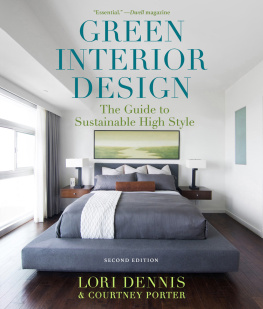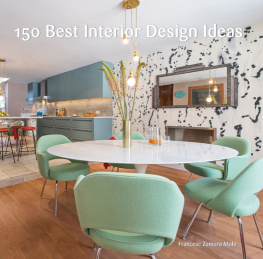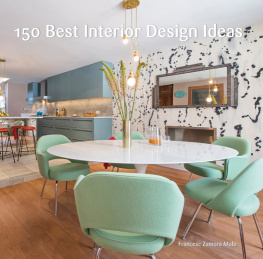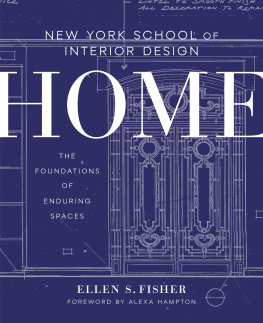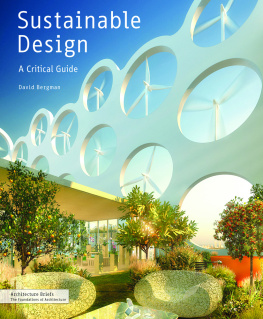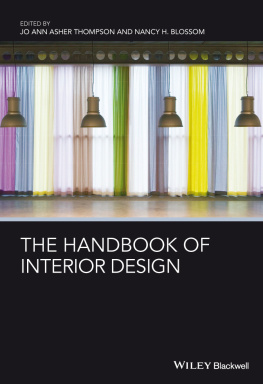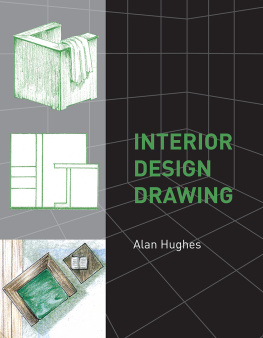Lori Dennis - Green Interior Design
Here you can read online Lori Dennis - Green Interior Design full text of the book (entire story) in english for free. Download pdf and epub, get meaning, cover and reviews about this ebook. year: 2020, publisher: Allworth, genre: Home and family. Description of the work, (preface) as well as reviews are available. Best literature library LitArk.com created for fans of good reading and offers a wide selection of genres:
Romance novel
Science fiction
Adventure
Detective
Science
History
Home and family
Prose
Art
Politics
Computer
Non-fiction
Religion
Business
Children
Humor
Choose a favorite category and find really read worthwhile books. Enjoy immersion in the world of imagination, feel the emotions of the characters or learn something new for yourself, make an fascinating discovery.
- Book:Green Interior Design
- Author:
- Publisher:Allworth
- Genre:
- Year:2020
- Rating:5 / 5
- Favourites:Add to favourites
- Your mark:
- 100
- 1
- 2
- 3
- 4
- 5
Green Interior Design: summary, description and annotation
We offer to read an annotation, description, summary or preface (depends on what the author of the book "Green Interior Design" wrote himself). If you haven't found the necessary information about the book — write in the comments, we will try to find it.
Green Interior Design — read online for free the complete book (whole text) full work
Below is the text of the book, divided by pages. System saving the place of the last page read, allows you to conveniently read the book "Green Interior Design" online for free, without having to search again every time where you left off. Put a bookmark, and you can go to the page where you finished reading at any time.
Font size:
Interval:
Bookmark:
CONTENTS

Its not easy being green.
Kermit the Frog
INTRODUCTION
There are plenty of reasons to go green. But you probably already know thatthats why youre here! You want to know how to go green. When it comes to sustainability and green interior design, our firm has been walking the walk long before green was trendy.
Welcome to the second edition of Green Interior Designthe expanded sequel of the book we first published in 2010. The first edition featured lots of resources for design-build professionals, many of which were inaccessible to the general public. Thats where this book is different.
Now, more than ever before, green has entered the mainstream. Its no longer just a fringe niche for new age hippies, its a necessity for everyone. Homeowners of all backgrounds are savvier than ever, and if youre reading this, we know youre interested in making smart purchasing decisions for your home. Were here to help you do thatstart to finish.
This book is infused with resources, green vendors to shop, and the best green interior design tips. Everything youll find here is something you can implement. This book was a collaborative labor of love within our firm. We hope youll enjoy it, interact with it, and share it with friends, family, and neighbors.
WHAT DOES GREEN MEAN TO YOU?
Perhaps up to this point, going green meant recycling water bottles, maybe even driving an electric car. With Green Interior Design, we want to challenge you to act bigger!
When you get into the weeds of building structures and furnishing your home, going green is not always going to be as simple as opting for paper straws over plastic. So strap in and embrace the words of our friend Kermit the frog, Its not easy being green.
A NOTE FROM LORI DENNIS
Green interior design is about living with intention and style. Its about having the realization that the decisions you make will affect the health and wellness of your planet, your family, and yourself. By reading this book, youve decided to make positive choices for your home, and to design a healthier and happier life.
Throughout most of my life, Ive experienced the impact that interior design can have on a person and the environment. My ideas about green living were formed in the early 1970s. Like many American kids at that time, I was raised by very young parents who didnt have much money.
The kids I knew recycled bottles for spending money, ate everything on our plates at every meal, and had the leftovers for lunch the next day. Wasting was frowned upon. Lights were always turned off when you left a room. We wore hand-me-downs, and our parents shopped at yard sales or thrift shops for household items.
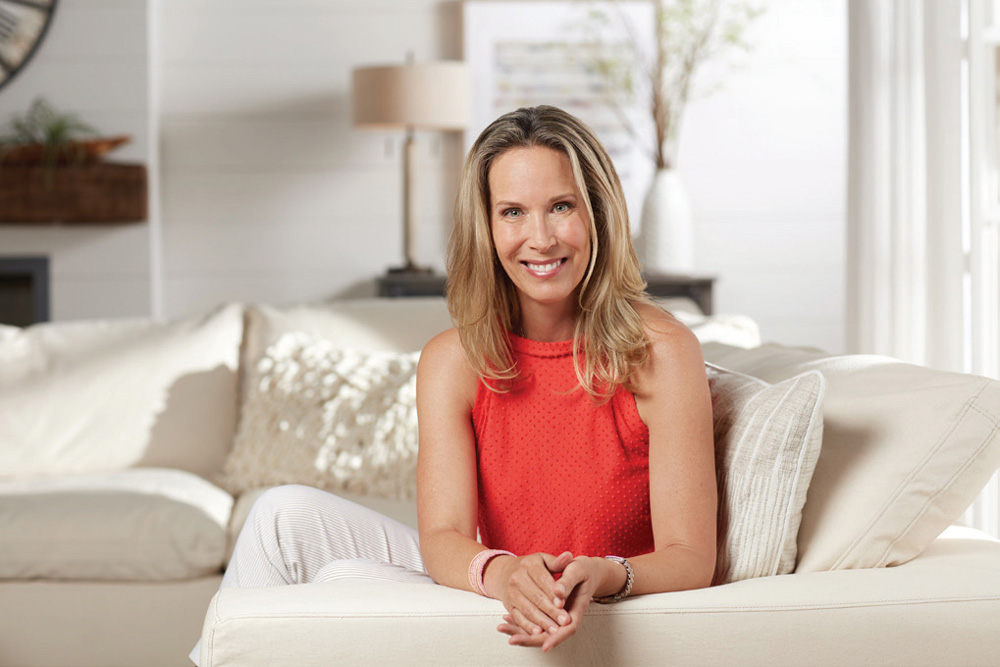
When we did buy something new, it was a high-quality product, usually made in an American factory, by people who were paid fair salaries. These factories were governed by laws that protected the workers and the environment. This meant that the products were expensive and therefore needed to last. When these things broke, you repaired them.
I was also raised by a mother who honored the Cherokee part of our heritage. We viewed the Earth as a cherished thing to be treated with the utmost respect. Littering, being wasteful, or polluting has always felt inherently wrong to me. But I have always loved pretty objects and wanted to be surrounded by themvalues our Cherokee ancestors held too.
My childhood bedroom was pretty bare. There were no decorations on the walls, and my bed was an ugly, green army cot, without a mattress on top of it. I didnt like being in that room; it was depressing.
But one day a set of Popeye cartoon sheets came in the mail, a gift from my aunt. The colorful sheets immediately transformed the room for me, turning it into a cheerful, bright place. I was actually proud of my bed after that. From that moment on, I understood how interior design could affect the way you feel about yourself and how you see the world.
Even as a kid, I noticed when things began to change in the 1980s. Western families became wealthy because of the expansion of credit. Factories rapidly began moving out of the West to third world countries where workers were paid unfair wages and there was little or no regard for their well-being or that of the environment.
Products became cheap enough to throw away and buy new. And as a result, the entire Western culture changed from being thrifty and mindful of waste to being okay with going into debt to buy disposable, cheap, toxic goods.
For the last four decades, manufacturers and consumers have been in a twisted relationship, where production and consumption matter much more than the pollution, illness, toxicity, and debt thats been created as a result. Weve reached a point where the oceans are filled with plastic from household goods, electronics, and water bottles. Entire ecosystems are dying as a result of our overconsumption.
When youre sick and running out of resources, it makes sense to return to healthy approaches and conservation. And thankfully things have a way of going in cycles. Baby boomers are downsizing, unloading possessions instead of buying more. And because of the high cost of living and debt, an entire generation of millennials reside in smaller spaces, with fewer things.
Pop culture is also shifting. Its becoming cool to place less value on things and more value on experience and meaning in our lives. Popular TV shows like Marie Kondos Tidying Up celebrate the joy of minimalism. Millions of people are opting out of purchasing or leasing their own private spaces to live and work, and instead chose to co-live and co-work in shared spaces.
Everyone has heard about being green, and millions of people are trying it out to see how it works for them. While we welcome you to jump in with both feet, be careful not to overdose. Our advice for getting started is dont try to learn everything on your first project. The amount of information is overwhelming to digest all at once. Thinking you can completely change to a sustainable way of being overnight is like joining a gym and expecting to have a six-pack the next day.
Remember that no project (or any built structure) is 100 percent green, not even the projects we share in this book. Try implementing some of the things you learn as you design or decorate your next project and improve on each subsequent one.
The most important thing to know is that training is critical. In addition to reading this book and the suggested additional reading, attend green building seminars, use experienced green contractors and trades, and graciously share your newfound knowledge with others as you learn and practice.
Get involved in your local community, and get involved in green decision-making when it comes to planning your city. Whew! Tired yet? Thats all right. As you continue making your way through this book, youll begin to feel confident as you learn more about the subject. Youll begin forming new eco-friendly behaviors. After time, they will become second nature.
Manufacturers, vendors, and the internet are making it easier, offering thousands upon thousands of green choices. Wed be lying if we told you all the products are as cheap as the mass-produced goods that usually come from China (with little or no regard to what effect the materials and manufacturing have on our planet and health). Still, as the demand for green products grows, prices continue to drop. So if you have to buy, buy green. We like to think of a time in the near future when we dont need to specify green anymore. Things will just be made with consideration for the environment and our health as common practice.
Next pageFont size:
Interval:
Bookmark:
Similar books «Green Interior Design»
Look at similar books to Green Interior Design. We have selected literature similar in name and meaning in the hope of providing readers with more options to find new, interesting, not yet read works.
Discussion, reviews of the book Green Interior Design and just readers' own opinions. Leave your comments, write what you think about the work, its meaning or the main characters. Specify what exactly you liked and what you didn't like, and why you think so.

